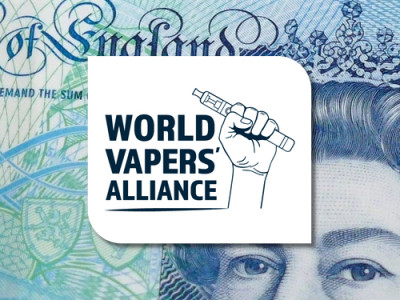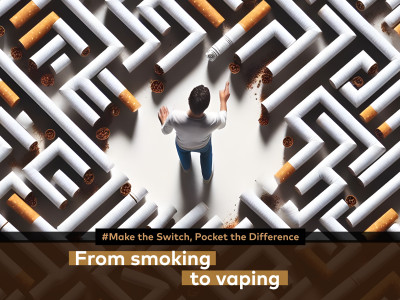"This is the first study of its kind,” said Assistant Professor Laura Struik, describing a piece of research identical to plenty of other pseudoscientific reams of junk. It, “makes direct links between reasons for youth uptake and the marketing strategies of e-cigarette companies. The public needs to know how the next generation is being targeted to take up and ultimately become addicted to these nicotine products."
Some might find it incredible to discover that similar ground-breaking studies were beginning to be churned out four years ago, like the daft one from Cambridge University [link]: “Advertisements featuring e-cigarettes with flavours such as chocolate and bubble gum are more likely to attract school children to buy and try e-cigarettes than those featuring non-flavoured e-cigarettes.”
At the time, Public Health England’s Kevin Fenton pointed out the obvious: “It’s important we recognise that flavoured e-cigarettes can appeal to adults as an alternative to smoking. In the UK we see very little evidence of E-cigarette use among children who haven’t previously smoked and this is partly due to the tight controls we already.”
Maybe Canada should be looking to the way it implements legislation? Maybe it should be focussing on the genuine figures of teen use rather than the now retracted lie, still being feverishly clung to by those valuing ideology above evidence?
Not Struik or her research partner Assistant Professor Sarah Dow-Fleisner. “It's clear teens do not use the products to quit smoking,” says social worker and not a scientist Dow-Fleisner, denying that vaping is overwhelming used a method to quit using tobacco products.
She added: "According to recent statistics, only three per cent of Canadian youth in grades 7 to 12 are current smokers—while 20 per cent use e-cigarettes. This suggests that upwards of 17 per cent of e-cigarette users were originally non-smokers. In addition, among youth who do smoke combustible cigarettes, fewer than eight per cent of those report using e-cigarettes to quit smoking."
This fails to appreciate that with declining sales of cigarettes, vaping is clearly operating as a disruptive reduced harm technology and preventing teens from rebelling through smoking. This, as they ought to have noted, is a ‘good thing’.
They can’t acknowledge that, though, as they cling to “emerging evidence of both short- and long-term health risks associated with vaping”. There is precious little reliable evidence of long term use evidence, and absolutely zero evidence of harm from short-term vaping.
“The TV advertisements we reviewed were found to tap into almost all of the reasons youth cite for taking up e-cigarettes. The most highly-cited reasons were most prominently presented in the ads, including a focus on relational aspects of vaping and product-related benefits, such as a positive sensory experience,” Dow-Fleisner wibbled.
"It is clear that we need to bring youth to the table to understand how we can generate relevant information and interventions to support their decision to not vape," added Struik, deflecting that it is actually her decision for them not to vape instead of smoking.
The advertising focus they objected to is legal in Canada [link] and an essential part of educating and encouraging adult smokers to switch to vaping. As researchers at The University of East London demonstrated in their work last year: “[Our] results from this study suggest that viewing an e-cigarette advertisement is unlikely to renormalise smoking among most groups. However, we observed some evidence that e-cigarette advertisements may increase how healthy cigarettes are perceived among dual users.”
Honest advertising of vape products is essential if countries like Canada are serious about combatting the carnage of tobacco-related disease and deaths. Struik and Dow-Fleisner should recognise that the puritanical quit-or-die approach has failed for decades and its long gone time they should be recognising the benefit harm reduction approaches can make in this field.
Related:
- “Tactics for drawing youth to vaping: A content analysis of e-cigarette advertisements”, Journal of Medical Internet Research – [link]
Photo Credit:
Image by Mikey from Wythenshawe, Manchester, UK, cropped from the original image on Wikipedia Commons licensed under the Creative Commons Attribution 2.0 Generic license
Dave Cross
Journalist at POTVDave is a freelance writer; with articles on music, motorbikes, football, pop-science, vaping and tobacco harm reduction in Sounds, Melody Maker, UBG, AWoL, Bike, When Saturday Comes, Vape News Magazine, and syndicated across the Johnston Press group. He was published in an anthology of “Greatest Football Writing”, but still believes this was a mistake. Dave contributes sketches to comedy shows and used to co-host a radio sketch show. He’s worked with numerous vape companies to develop content for their websites.
Join the discussion
Harm Reduction For The Rich
The United Kingdom risks becoming a harm reduction country only for the wealthy, according to Michael Landl of the World Vapers’ Alliance
CAPHRA Highlights Tobacco Control Flaws
The Coalition of Asia Pacific Tobacco Harm Reduction Advocates highlights the flaws in tobacco control which has led to the rise of black market in Australia
A Missed Opportunity at COP10
The Smoke Free Sweden movement says that COP10 was a missed opportunity to save millions of lives
COP10: Promote Tobacco Harm Reduction
Experts with Smoke Free Sweden are emphasising the urgent need for a Tobacco Harm Reduction approach at COP10












